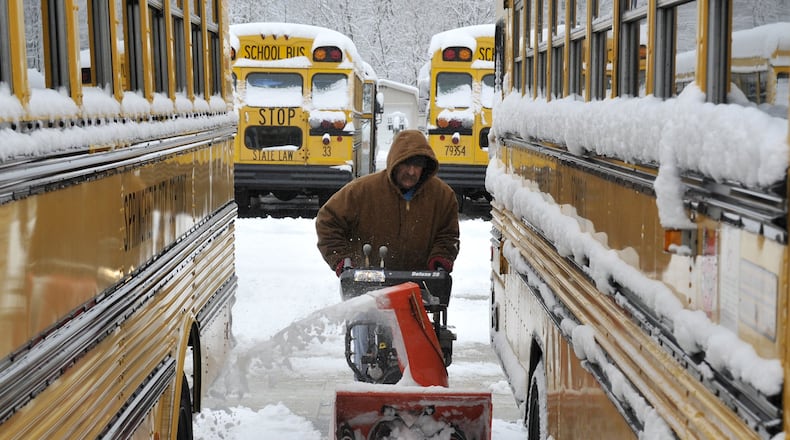During inclement weather, most districts have faculty who drive the roads in the mornings to assess the road conditions, monitor weather forecasts, temperatures and wind chills, and communicate with other districts to determine if they should have a two-hour delay or close.
“Weather conditions are both variable and potentially extreme in Ohio; however, the safety of children will guide decisions regarding delays or closures,” said Springfield City School Superintendent Bob Hill.
Many schools make their first decision to delay or close by 5:30 a.m. During a delay, they use that time to continue assessing road and weather conditions, then decide to close school if needed by 7:30 a.m.
The timing of the weather Tuesday morning presented a challenge because snow fell and subzero windchills came close to the time most students and staff would head to schools.
In the Springfield district, the goal is to announce delays or closures as soon as possible, and try to make them the night before when possible. If they can’t make the determination the night before, the superintendent and a team of employees start at 4 a.m. the next day to assess conditions. They review temperatures and wind chills, and drive in the district to assess the roads, sidewalks and parking lots.
“After evaluating the weather and road conditions, the team discusses potential safety concerns, reports from other area schools and law enforcement officials, additional weather reports from multiple sources, as well as information from city and county road crews,” Hill said.
The superintendent reviews all information and makes the decision to delay or close between 5:15 and 5:30 a.m. However, with changing road and weather conditions, the decision is sometimes made as late as 6 or 8 a.m., depending on if more time is needed to make it.
“On days that a delay schedule is implemented and later changed to a closing, road conditions either worsened, or despite the best efforts of county, city or state road crews, roadways were not adequately cleared or treated,” Hill said. “Ultimately, school will be in session only if our bus drivers can safely navigate buses on the SCSD roads that must be traveled to transport our students.”
At Global Impact STEM Academy (GISA), founding director and superintendent Josh Jennings said their decision is based on what the majority of schools in the county do.
“For example, if Springfield City School District closes or delays, we will likely do the same because they have most students who attend GISA,” he said. “Outside of that, if the majority of students are affected, we follow the majority of schools.”
Just as in the Springfield district, those at Clark-Shawnee and Greenon Local Schools make decisions with student and staff safety in mind. Clark-Shawnee Superintendent Brian Kuhn said the “decision is always based on the ability to safely transport students to school and for student drivers to safely make it to school.”
The first decision is needed no later than 5:45 a.m., Kuhn said. On Tuesday, at the time, “the roads and weather warranted a delay,” he said.
When he and the transportation supervisor were out checking, “we had to make the second decision by 7:30-7:45 a.m. The road conditions were still poor and the weather was still poor,” Kuhn said. “We determined that transportation via school bus was just not safe.”
School districts in Champaign County, including Graham Local, Mechanicsburg Exempted Village and Urbana City, have the same process as those in Clark County, with the goal to keep bus, student and parent drivers, students walking and waiting at the bus stops safe.
“Sometimes, a delay can provide the necessary time for roads to clear and the parking lots and sidewalks to be cleaned. If the delay does not appear to provide this time, a decision to close will be made,” said Graham Superintendent Chad Lensman.
Another issue that some districts, such as Graham, take in to consideration is that some roads could be clear while others are still unsafe.
“With the district being so large, there could be parts with clear roads or less fog than others, but the unsafe areas still show a need for a delay or cancellation. Also, there are many times when the main roads are safe to travel, but many of our back roads are untouched and do not provide that same safety,” Lensman said.
About the Author

